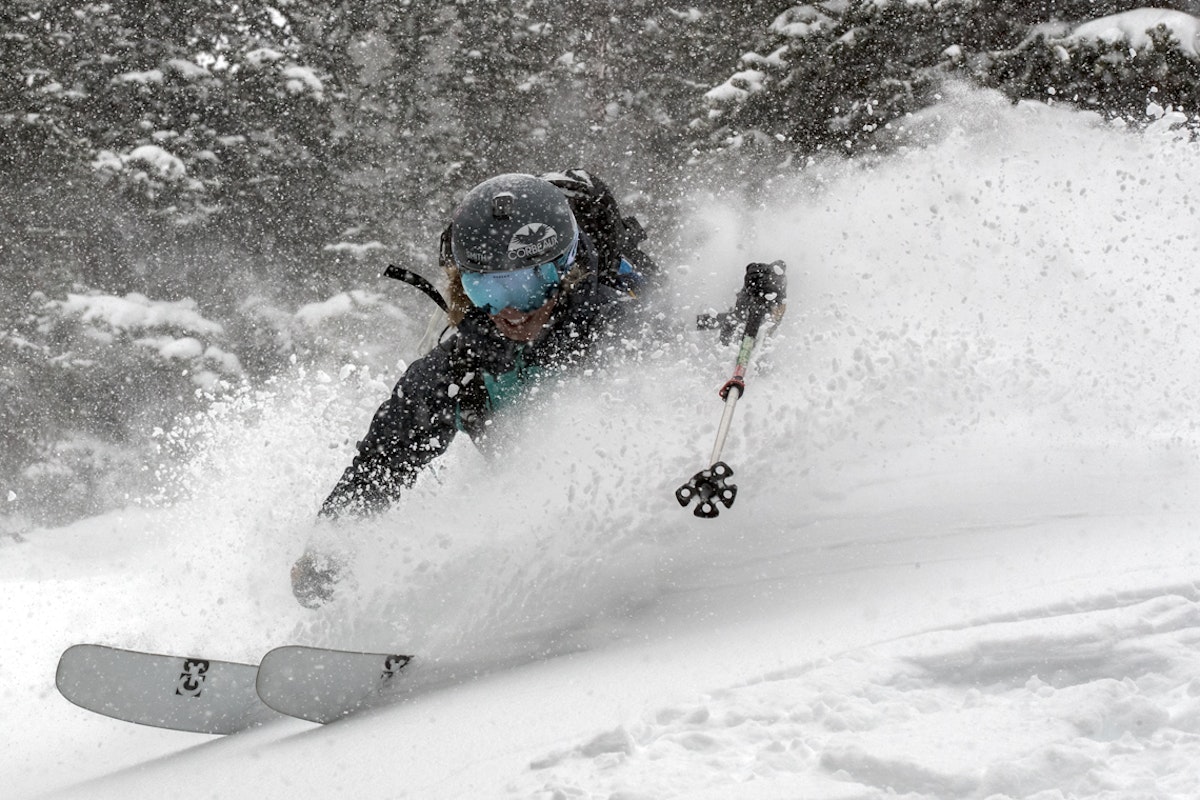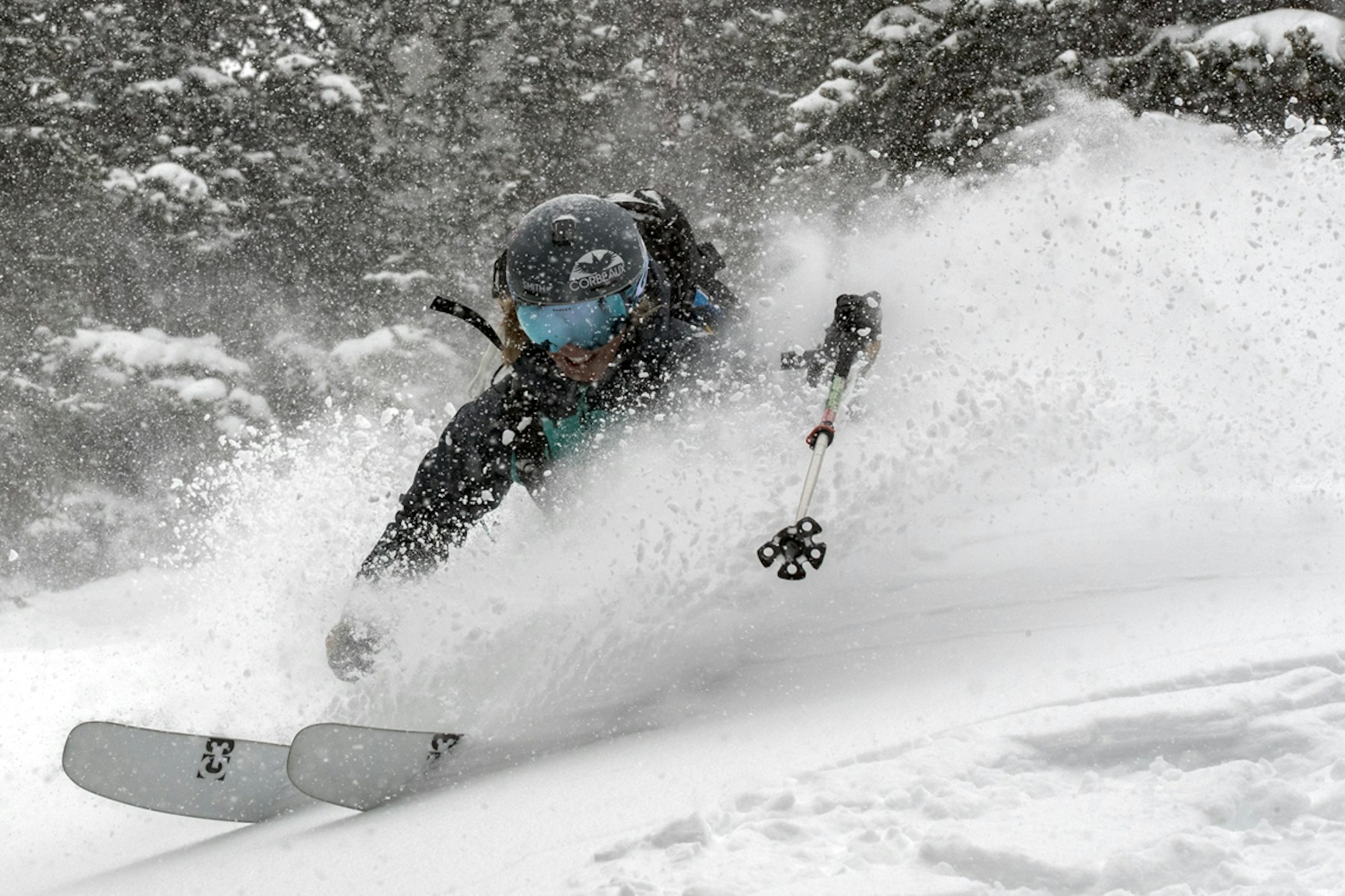Featured Image: Jeff Cricco
Backcountry Skis
General Characteristics:
– Built with lighter woods and composites
– May have a squared-off tail and/or rivets for climbing skin attachment
– Directional flex
– Designed for those who care as much about the up as they do the down
1. 4FRNT Hoji


The Hoji is built to transport you efficiently to incredible big-mountain objectives, then whisk you down them at high speed via long, arcing turns. “Was skeptical about the weight, but it was amazing on the skin track,” noted tester Jacob Dalbey. “Then, the descent was like a dream!” The ski’s efficiency on the skin track comes from the use of paulownia wood in the core. 4FRNT pairs it with poplar for an energetic personality on the descent. The Hoji’s full reverse camber profile makes it a dream in deep powder, yet 4FRNT’s ReflectTech construction—sidecut that matches the rocker profile—makes it more than capable on edge and in choppy conditions. If you live in big backcountry terrain, the Hoji is for you.
2. Armada Tracer 108


The Tracer 108 puts equal focus on uphill efficiency and freeride performance. In fact, Armada calls it the love child of the featherweight Kufo 108 and hard-charging Norwalk. The ski weighs a manageable 1,885 grams per ski, but a stiff character—owed to camber underfoot and a stiff composite insert—ensures it can rip any backcountry zone to shreds. “These skis were incredible on the uphill,” explained Jacob Dalbey. “Even though they were super light on the up, they charged like a ’76 Corvette on the descent.” Those who consistently seek soft snow conditions in the backcountry and prefer a slightly wider waist width will find the Tracer 108 a trustworthy companion.
3. Fischer Hannibal


With its slim build, low weight and stiff personality, Fischer’s Hannibal is an incredible peak-bagging ski. To shed those grams, Fischer mills offset channels into the underbelly of the wood core, reducing weight without loss of rigidity. To further stiffen up the ski, Fischer utilizes Titanal inserts in the binding area as well as carbon stringers running the entirety of the ski. This allows the Hannibal to hold steady in even the tightest or most exposed peak descents. “The Hannibals are featherweight and climbed incredibly well,” explained Charlie Davidson. “They charge as hard on the downhill as they did on the uphill.” Of course, the Hannibal is best enjoyed with a nice glass of Chianti.
4. G3 SEEKr 100


A brand-new offering from the Vancouver, British Columbia-based G3, the SEEKr is the brand’s most playful ski, to date. It employs a three-dimensional poplar and paulownia wood core for weight savings and energy, two layers of carbon fiber for a boost in torsional stiffness and an early rise tip and tail to yield a surfy ski that’s still able to grip the slope during spicy descents. “I was really impressed with this ski,” explained Darcy Conover. “I loved the rocker profile in the deep powder. They’d be great for deep winter tours and longer days, too, because of their low weight.”
5. HEAD KORE 105


The KORE 105 is a wonderful option for those who often find themselves utilizing resort gates to access the backcountry. The ski is built mostly with downhill performance in mind, but Head’s use of karuba wood and ultra-thin Graphene sheds enough weight to make this a dependable touring ski, too. Tip and tail rocker make the KORE 105 a standout in powder and the trees, while traditional camber underfoot ensures stability in variable conditions. “A great sidecountry ski for deep days and varied terrain. Would be awesome in spring corn, too,” commented Darcy Conover. Charlie Davidson added, “Downhill-oriented, but the dampness and power were well worth it for the descent.”
6. Icelantic Natural 101


The Natural 101 is Icelantic’s brand-new touring-specific ski. Icelantic employs an ultra-lightweight balsa wood core that makes the Natural 101 an absolute dream on the skin track. It pairs the wood with triaxial woven fiberglass to give it a boost in strength without any bulk for an increase in downhill performance, while a rocker-camber-rocker profile provides the versatility to rip up powder, chunder and windbuff. “This ski toured well, floated, carved and maneuvered on a dime,” commented FREESKIER’s Donny O’Neill. “Downhill was its strength, but its uphill prowess was pretty high. I’d recommend it for normal midwinter tours as well as those accessing the backcountry from the resort.”
7. K2 Wayback


K2 relied upon a team of backcountry ski guides in the development of the Wayback 106. The testing crew skied prototypes across the globe, and this ski is the culmination of their research. The Wayback 106 utilizes a balsa wood core with integrated flax fiber strands for dampening, two layers of carbon-fiberglass and a Titanal backbone that extends out to the tip and tail for a ski that’s an efficient tourer but an absolute monster on the downhill. “I wish I had a pair of these on top of any mountain at any time,” commented Charlie Davidson. “Rename them the Postmaster General because these are full
8. Völkl Mantra V.Werks


The Mantra V.Werks is a ski without a speed limit that’s as happy crushing mid-winter pow as it is hopping down steep spring peak descents. It lies on the stiffer side of the spectrum thanks to traditional camber underfoot, a titanium backbone and a carbon wrapping, but tip and tail rocker help this ski’s playfulness and keep it nimble. “Lightweight and easy to maneuver on the uphill,” described FREESKIER’s Donny O’Neill. “Snappy and quick on the descent through the trees, planed very well in the deep powder pockets.” Adam Moszynski added that it was “light and efficient on the uphill. It was really nimble on the descent, making quick turns easily.” Fans of the resort-centric Mantra, step right up and see what this version can do out-of-bounds.



![[GIVEAWAY] Win a Head-to-Toe Ski Setup from IFSA](https://www.datocms-assets.com/163516/1765920344-ifsa.jpg?w=200&h=200&fit=crop)


![[GIVEAWAY] Win a Legendary Ski Trip with Icelantic's Road to the Rocks](https://www.datocms-assets.com/163516/1765233064-r2r26_freeskier_leaderboard1.jpg?auto=format&w=400&h=300&fit=crop&crop=faces,entropy)




![[GIVEAWAY] Win a Head-to-Toe Ski Setup from IFSA](https://www.datocms-assets.com/163516/1765920344-ifsa.jpg?auto=format&w=400&h=300&fit=crop&crop=faces,entropy)


